2007 VOLKSWAGEN GOLF PLUS inter
[x] Cancel search: interPage 172 of 541
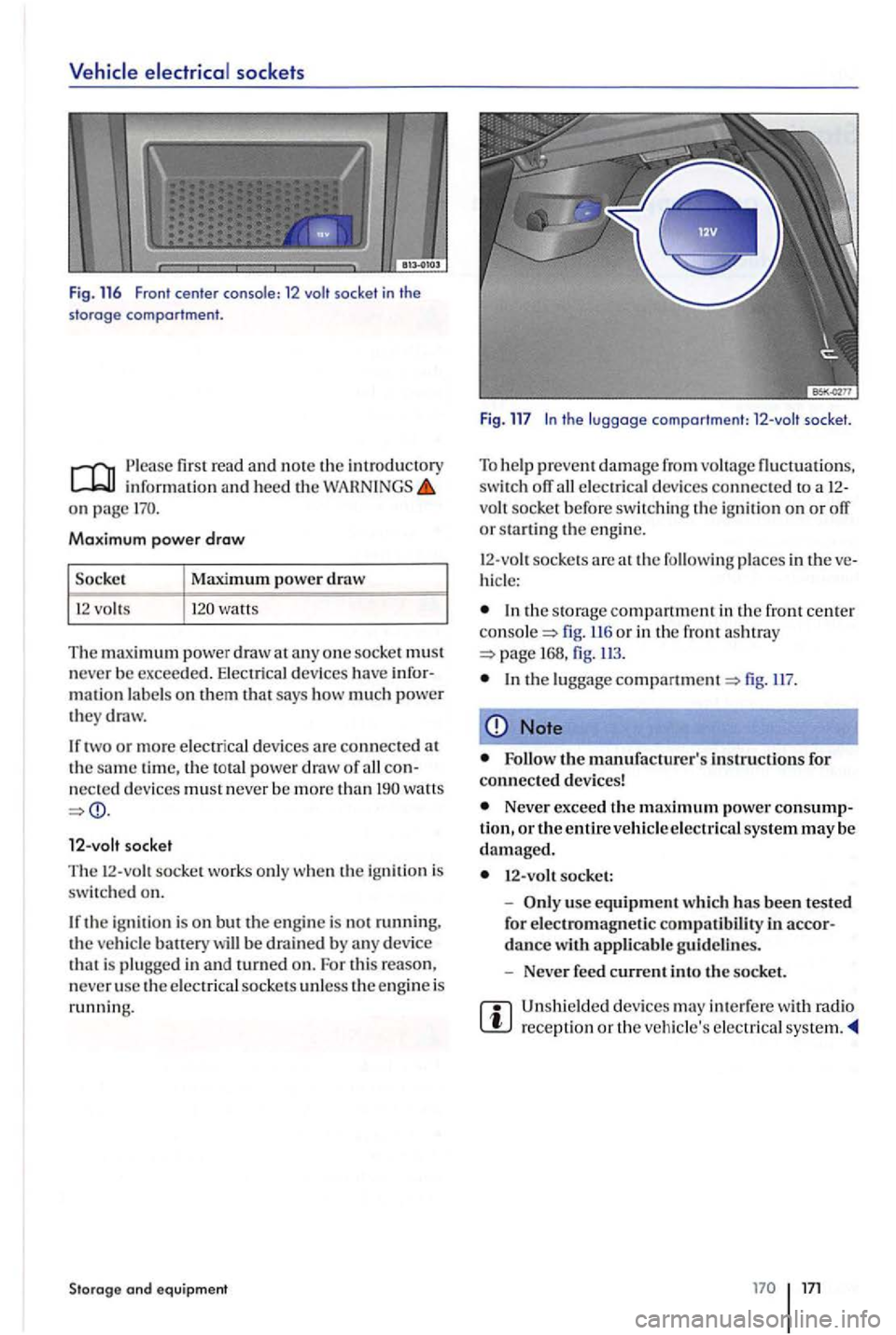
sock ets
F ig . 116 Fron t cente r conso le : 12 socket in the
sto rage comportment .
first r ea d and note the introductory information and heed the on page
Maximum power draw
watts
The maximum power draw at any one socke t must never be exceede d. Electrical devices have infor
m ation labels on them that says how muc h power they draw.
watts
socket
The socke t works only when the ig nition is swit ched on.
the ignition is on but the en g in e is not running. the ve hicl e battery will be drain ed by any device tha t is p lugged in and turned on. For this reason.
n ever use the e lectrical socke ts unl ess the engine is running.
Storage and eq uipment
Fig. 117 socket.
To h elp prevent damage from voltag e fluctuations,
swi tch off electric al devices connected to a 12-vo h socke t before swit ch ing the ignit ion on or
places in ve
hicl e:
the storage center fig . 116 or in the front ashtray 168, fig .
lugga ge fig.
Note
the manufacturer's instructions for
connected dev ic es!
Never exceed th e m aximum power consumption, or the entire ve hicl e electrical system may be damaged.
use equipment which has been tested for applicable gu ideli nes.
Neve r feed current into the socket .
Unshielded devices may interfere with radio reception or the veh icle's electrica l
Page 182 of 541

with manual transmission: Clu tch
Plea se first re ad and note th e in troducto ry information and heed th e on pag e
usc floor mats that leave the pedal area fre e and ar e held sec urel y in plac e w ith floor mat fas
t e n ers to help prevent slidin g.
with automatic transmis
s io n : Accelerator pedal, Broke
in the driver footwell can prevent the pedal s from moving fr ee ly . Thi s ca n ca use loss of vehicl e control and increase the risk of serious
p ersonal injurie s.
Never put floor mats or other floor coverings
o n top of alr eady in stalled floor mats.
Always make sure that n o thing can f all into
th e driver footwell while the vehicl e is mov ing.
CD Note
Alway s make sure that the pedals arc abl e to move
fre ely and that nothing ca n interf ere with them.
For examp le, if a brak e ci rcui t malfun ction s, more brake pedal trave l will be needed to bring the ve
hicl e to a full stop, and yo u will have to depress th e
brake pedal harde r and further than
Page 193 of 541
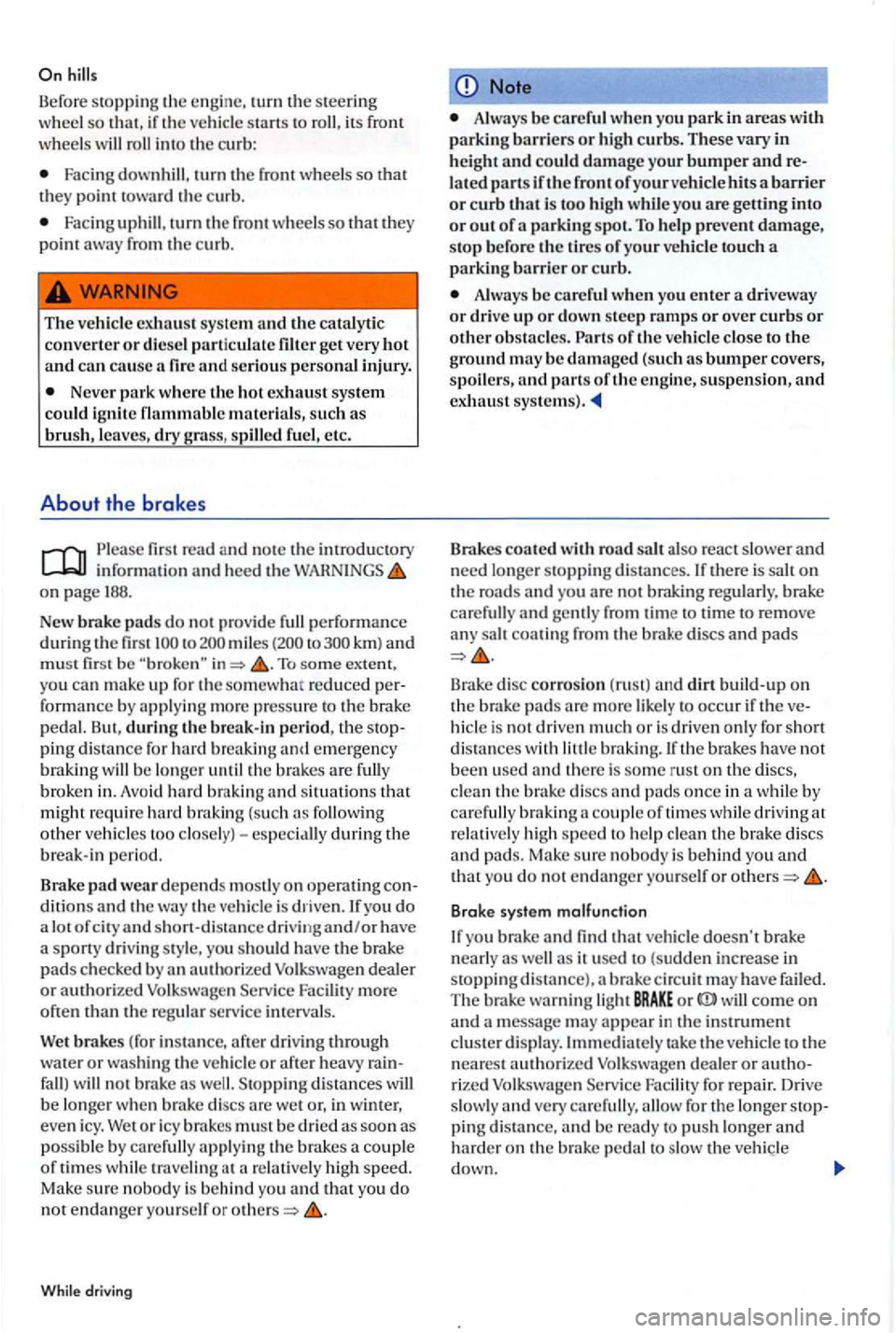
Befo re stopping th e en gine, turn the s teerin g
w heel so th at, if the ve hicl e sta rt s to its w heels w ill int o th e curb:
Fac ing turn the fro nt whee ls s o th a t
they point t oward the curb .
Fa c in g uphill , turn the front whee ls so that th ey
p o int away from the curb .
WARNING
The vehicl e exh aust system and the catalyt ic
co nverter or diesel particulate filter get very hot and can cause a and serious personal injury.
Never park where the ho t exhaust system could ignite flammable m aterial s, su ch as brush, leaves, dry grass , spilled fuel, etc.
About the brakes
read and note th e introductor y information and hee d th e on page 188.
New d o not provi de to miles to km) and m ust firs t be
hard braking and situ atio ns that
mi ght re quir e hard braking (such follow in g other vehicles too closely)-during the break-in period .
pad wear depe nd s m ostly o n operatin g the vehicle is d riven.lfyou do a l ot o f ci ty and shor t-dis ta nce driv ing and/or have
a sp o rt y driv in g s ty le, yo u sh ould have th e brake
p ad s checke d by a n authorized Vol ksw age n d eal er or a u thori ze d Volkswagen Service Fa cilit y m ore
o fte n than the regula r servi ce interva ls.
Wet
r e la tive ly hi gh speed.
Mak e sure nobo dy is be hind you and that yo u do
not endanger yo urself or
Not e
Alwa ys be careful when you park in areas with parking barriers or high curbs . T hese vary in heig ht and could damage your bumper lated parts if the front of your ve hicl e hits a barrier or curb that is too high while you are getting into or out of parking spot. To help prevent dam age,
s top b efore the tires of your ve hicle touch a parking barrier or c urb.
Alwa ys be c areful when you enter a or down steep ramps or over curbs or other obstacl es. o f th e v ehicl e close to the ground be damaged (such as btm1per covers,
s p oi lers, and parts of the en gine, suspension, and exhaust sys tems).
coa ted with road sa lt also react slowe r and need lo nge r stopping dis ta n ces. there is salt o n
t h e ro ads and you are no t b raki ng reg ularly , b ra ke carefully and ge ntl y from tim e to tim e to rem ove
a n y salt coa ting from the bra ke discs an d pad s
Brake d isc corro sion (rust) and dirt buil d-up on
th e br
ake pads are m ore like ly to o ccur if th e hide is no t dri ven muc h or i s drive n only fo r sh o rt dista nces w ith littl e brakin g. th e brake s have not
been use d and th ere is so me ru st o n t he di scs, clean th e brak e discs and p ad s o nce in a whi le by carefully braking co upl e of times whi le dri v in g at
r e lati vely hi gh sp ee d to help clean the bra ke di scs
and pad s. Mak e sure n o bod y is behind you and that you do no t enda nger yo urself or
B rake system malfunction
you brake and
th e ve hicl e to the n earest authorize d Volkswage n dea ler or
p in g d is ta nce, and be ready to pus h lo nger and harder on th e brak e pedal to slow th e ve hicl e
d own.
Page 200 of 541
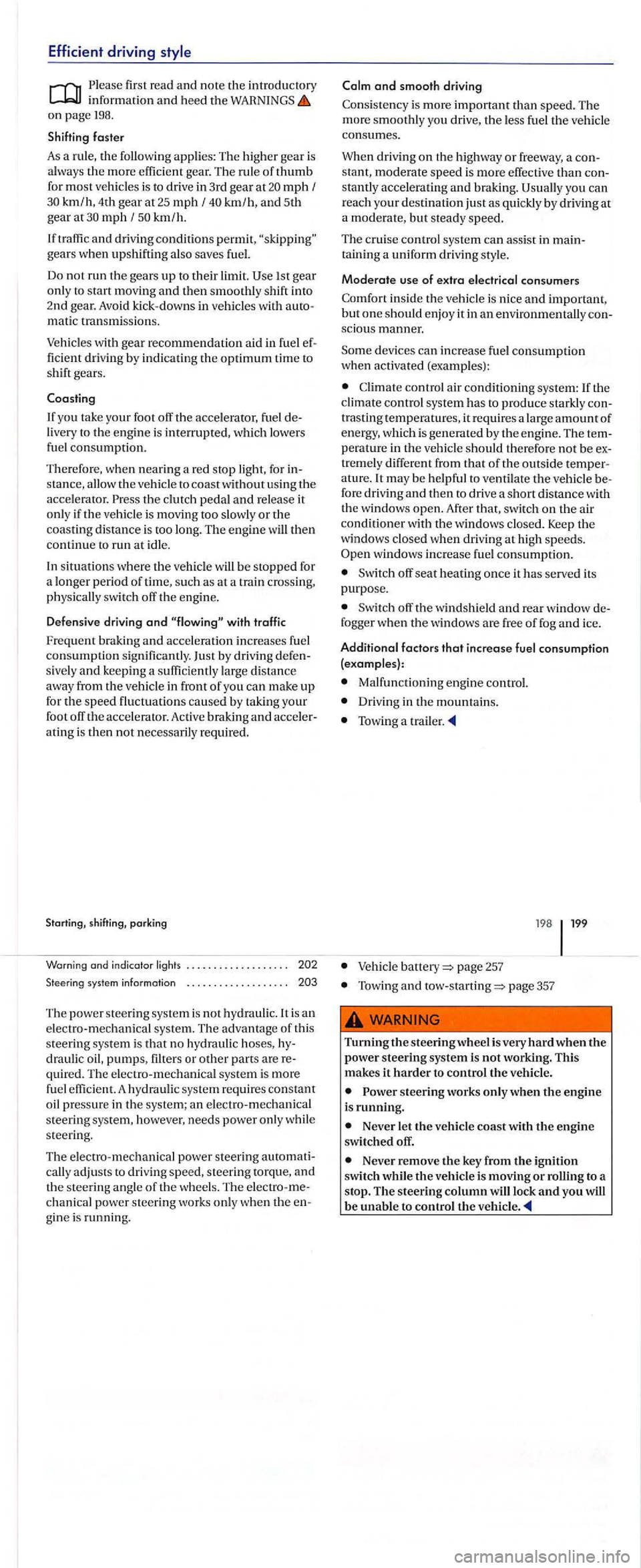
Efficient driving
Please information and heed the on page 198.
Shifting faster
As a rule, the following applies: The higher gear is
a lways the more efficient gear. The rule of thumb for most vehicles is to drive in 3rd gear at mph f km/h, 4th gear at 25 mph f km/h, and 5th gear at mph f km /h.
If
and driving conditions permit, gears when upshifting also saves fuel.
Do
not run the gears up to their limit.
mati c transmissions .
Vehicles with gear recommendation aid in fuel fic ient dri ving by indicating the optimum time to shift gears.
livery to the engine is interrupted, which lowers
fuel consumption.
T herefore, when nearing a red stop light , for s tanc e, allow the vehicle to coast without using the accelera tor. Press the clutch pedal and release it only if the v ehicle is moving too slowly or the coasting distance is too long. The engine will then continue to run at idl e.
In situati ons
where the vehicle will be stopped for
a longer period of time, such as at a train cros sing,
physically switch off the engin e.
D efens ive driving
and with traffic
Fre
quent braking and accel eration increases fuel consumption sign ific antly. Just by driving sivel y and keeping a su fficiently large distance away fro m the vehicle in front of you can make up for the speed fluctuation s caused by taking your foot off the accelerator. Active braking and ating is then not necessarily required.
system information
The power stee ring syste m i s not hydrauli c.lt is an electro-mechanical syste m. The advantage of this
s te ering system is tha t no hydra uli c hoses, draulic oil, pumps, filters or other parts are quired . Th e e lectro-m echanica l system is more fue l effi cient. A hydraulic system requires constant oil pressure in the syste m; an electro -mechanical
s teerin g sys tem, however, needs power only whil e
s teering.
Th e el
ectro-mechanical power steering
chanical power steering works only when the gin e is running.
and smooth driving
Consistency is more important than speed. The more smoothly yo u drive, the less fuel the vehicle consumes.
When driving on the highwa y or freeway, a
stantly accelerating and braking. you can r each your destinatio n just as quickly by driving at a moderate, but steady speed.
The c rui se control syste m can a ssis t in
sciou s manner.
Some dev ices can increase fuel consumption when activated (examples):
C limate control air conditioning system:
trasting temperatures, it requires a large amount of energy, which is generated by the e ngin e. T he
tr emely different from that of the outside
windows increase fuel consumption.
Switch off seat heating once it has served its
purpose.
Sw itch off the windshield and rear window
Malfunctioning engine control.
Driving in the mountains.
Towing a trailer .
page 257
Towing and page 357
Turning the steering wheel is very hard when the power steering system is not working. This makes it harder to control the vehicle.
steering works only when the engine is running.
Never let the vehicle coast with the engine switched off.
Never remove the key from the ignition
switch while the vehicle is moving or rolling to a
stop. The steering column will lock and you will be unable to control the vehicle.
Page 201 of 541

Fuel-efficient driving
Fig. 131 Fuel consumption in ferent ambient air temperatures .
info rmation and heed the on page 198.
Dri vin g defensive ly and economically can easily
r educe fuel con sumption by to 15 % .
The ve hicle consu mes the most fu el w he n atin g. D efe nsive dri vin g require s less brakin g and therefore less accelerat ion. If possib le, coast the ve hicle to a sto p, for exa mple, when yo u ca n see th a t th e next traffic ligh t is red or is about to turn
red.
Avoid traveling short distanc
es
A cold engine consumes sig nificantl y more fuel
imm ediately after sta rtin g. It take s a few miles fore the engi ne is warm ed up and fuel tion i s stabili zed.
To reduce fuel consumptio n and the emission of pollutants effect ive ly, the e ng in e and ca talytic
conve rter must reach th eir optimal operating
ica l in thi s context.
fig. 13 1 displays the v a ry ing fuel consumption rates
for the same d istance dri ven, once at +68 and once at + 14
th e e ngin e run to warm is not o nl y lega l in some co untries, but also technicall y not
n ecessary and wastes fu el.
Adjust the tire pres sure
T he prop er tir e
pressure help s reduce rollin g tance as well as fue l co nsumption. In additi on ,
slig htl y higher tire pressure(+ 3 psi I+ bar) ca n
h e lp save fuel.
If you ca n a ccept a slight los s in comfort, the ommend ed tir e pressure for a fully loade d ve hicl e
ca n be used. This als o applies to so litary dri vin g and driv ing withou t lu ggage loa ds.
When purchasing new t ires, alway s ma ke sure th at
th e tires are optimi zed for lower rollin g resis tance.
Us e low viscosity engine oil
F ull y sy nth e
tic, low viscosity e ngine oils reduce
fuel consumption. Low viscosity e ngin e oils duce the fric tional res istance on th e engine and are dis tributed m ore evenly and qui ckly, larly w hen co ld -s tarting the engine. The effect is parti c ularl y apparent in vehicles th at frequentl y
tra vel s hort dis tan ces.
A lways ens
ure th e righ t e n g in e oil leve l is ta in ed and keep to the sc h edul ed serv ice interva ls
(e ng ine oil ch an ges).
W
hen purch asing e ngine oil, always ch eck th e Volksw agen en gine oil standard and approval.
Avoid unnecessary weight
The lighter th e ve hicl e, th e more economica l and ceo-friend ly it w ill be. For in stance, an extra
H e m ove
consum e. Aftermark et co mponents s uch as
ro of or b icycle racks dimin is h its aerod yn a m ic fonnan ce.
Th erefo re, re
mov e un necessary aftermark e t ponents and unused rac k systems, parti cul arly if ....... -
fir st read and note th e introductory informa tion and h ee d th e WAHNINGS page
response
Ha ve the power stee rin g sys te m ch ec ked ste eri ng failure. mediatel y by an authori zed Volk swag en deale r
o r a n authorized Volk swagen
Fac ility. steeri ng ass is t i s reduced. re start the e n gine, and dri ve a sh ort tan ce. If th e yello w warning light does not
c o m e on again, you do not need to have th e
s te ering syste m ch ec ke d .
Vehicle battery was di sconnected and has Drive a short distan ce at 12 mph been reconnec te d . km/h).
F lashes re sponse
Elec troni c steering column lo ck malfunc -
which m ay appea r in the in strument clu ste r
di sp lay. loc ke d.
W
hen the i g nit ion is switc h ed on, seve ra l wa rnin g and indicator lights come on bri efly for a f un ction ch e ck . T hey go out after a few seconds.
Failure to
heed warning light s and in strument cluster text m essages can cause th e vehicl e to break down in t raffic and result in a collisio n and seriou s personal injury.
Neve r igno re warning lights or tex t
Do not dri ve if th e s teerin g co lumn remains
l ocke d switch in g th e ig niti on on aga in.
Ge t expert assis ta nce.
Alwa ys sto p the vehicl e as soon as it is safe to do so .
Note
Failur e to heed warning lights or tex t WARNINGS can res ult in vehicl e damage
Page 206 of 541
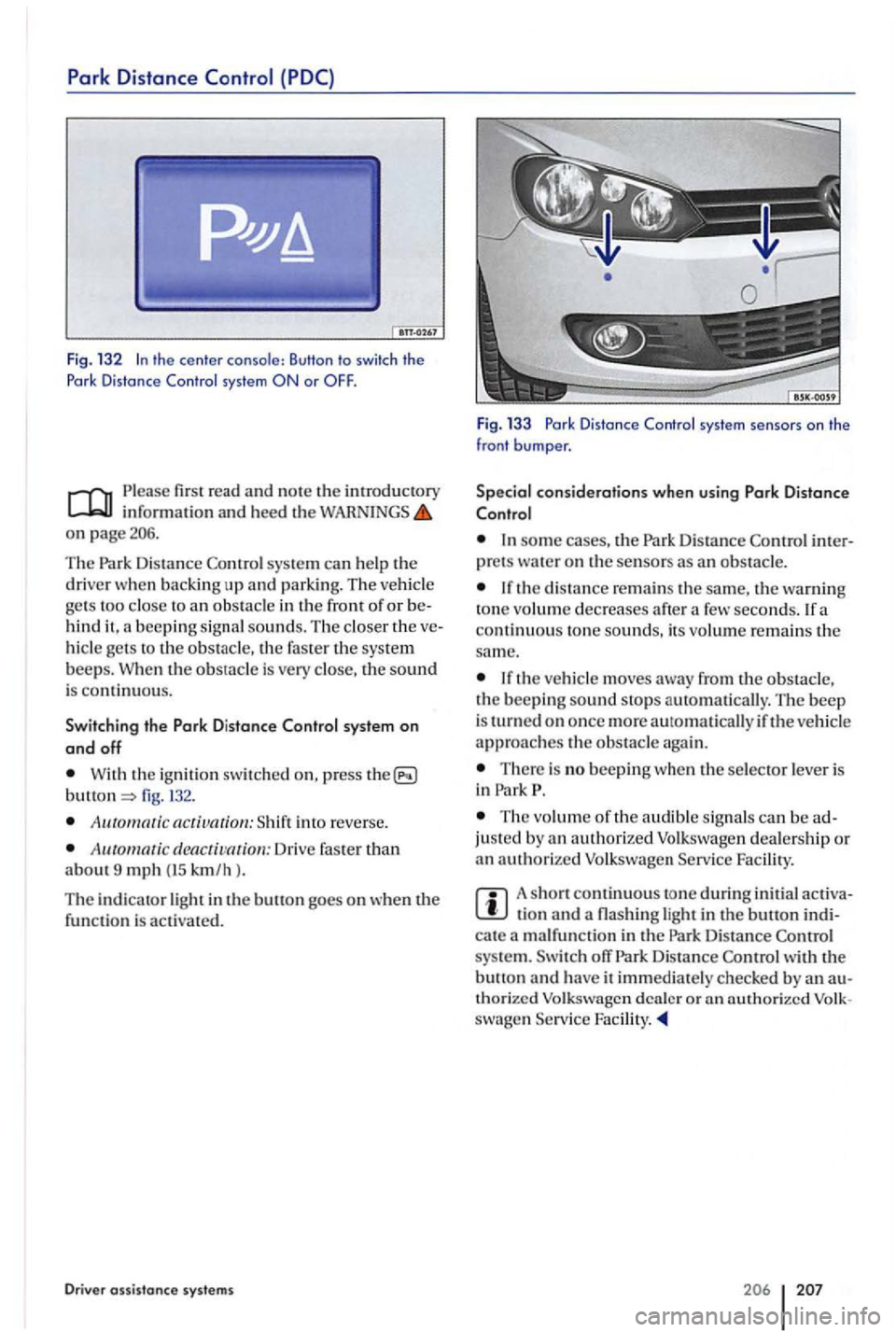
Park Distance (PDC)
Fig. 13 2 the center console: Button to switch th e
P ork Distance Control system
Please first read and note the introductory information and heed the on page
system can help the driver when backing up and parking. The ve hicle
ge ts too close to an obstacle in th e front of or behind it , a beeping sig nal sounds. Th e closer the ve
hicl e gets to the obstacle, the faster the system beeps. W hen the obstacle is very clo se, the sound is conti n uous.
Switch in g the D istance Contr ol sys te m on
a
nd off
W ith the ignit ion switc hed on, press the fig. 132.
A u into reverse .
denctivatiou: Drive faster than about 9 mph (15 km/h ).
T he indi cator
light in the button goes on
Distance Control
some the Park Distance Control interpret s wa te r o n the sensors as an obstacle.
I f th e dista nce remains the same, the warnin g
ton e volume decreases after a
There is no beeping when the selector lever is
in Park P.
The vo lume of the audib le s ig n als can be ad
justed by an authorized Volk swage n dealership or an authorized Volkswagen Service Facility.
A short continuous tone during initi al activation and a light in the button indicate a malfunction in the Park Distance system. Switch off Park Distance Control w ith the button and have it immediate ly checked by an au
thori zed Volkswagen deale r or
Page 227 of 541

Never switch th e fan off for an extended p eriod of time, sin ce no fresh ai r will enter the senger compartment.
air causes driver and passenger fatigue and reduces their alertness, whi ch can cause cidents, collision s, and serious personal
Heating system operation
A
Fig . 145 In th e center console: Heati ng system rotary con trol with control elements in
fir st r ea d and the introductor y information and heed the on page226.
K
eep the air imak e slo t in front of the wind shield fr ee of ice, snow and leaves in order to m aint ain
t h e prop er fun ctioni ng of th e heatin g sys te m.
Temperature
T he desired interior t emperatur e cannot be lowe r
t han th e out sid e a ir, beca use the heating system cannot cool or dehumidify the air.
Heating
Maximum heatin g ou tp ut and fast defrosting only be poss ible after the engine has reac hed ati ng temperature.
for optimal driving safety
off air pag e 232.
Turn the temperature knob to th e ce nter tion.
Ope n
Turn the air di stribution knob to th e des ired
se ttin g.
The dust and filter
T he du st and filt er wit h an activated carbon insert red uces th e entry of pollutant s int o the
turely due to ope ra tin g the vehicl e w here th e side air is heavily pollut ed, th e dust and polle n filt er sh ould be rep laced more frequently than
Page 230 of 541
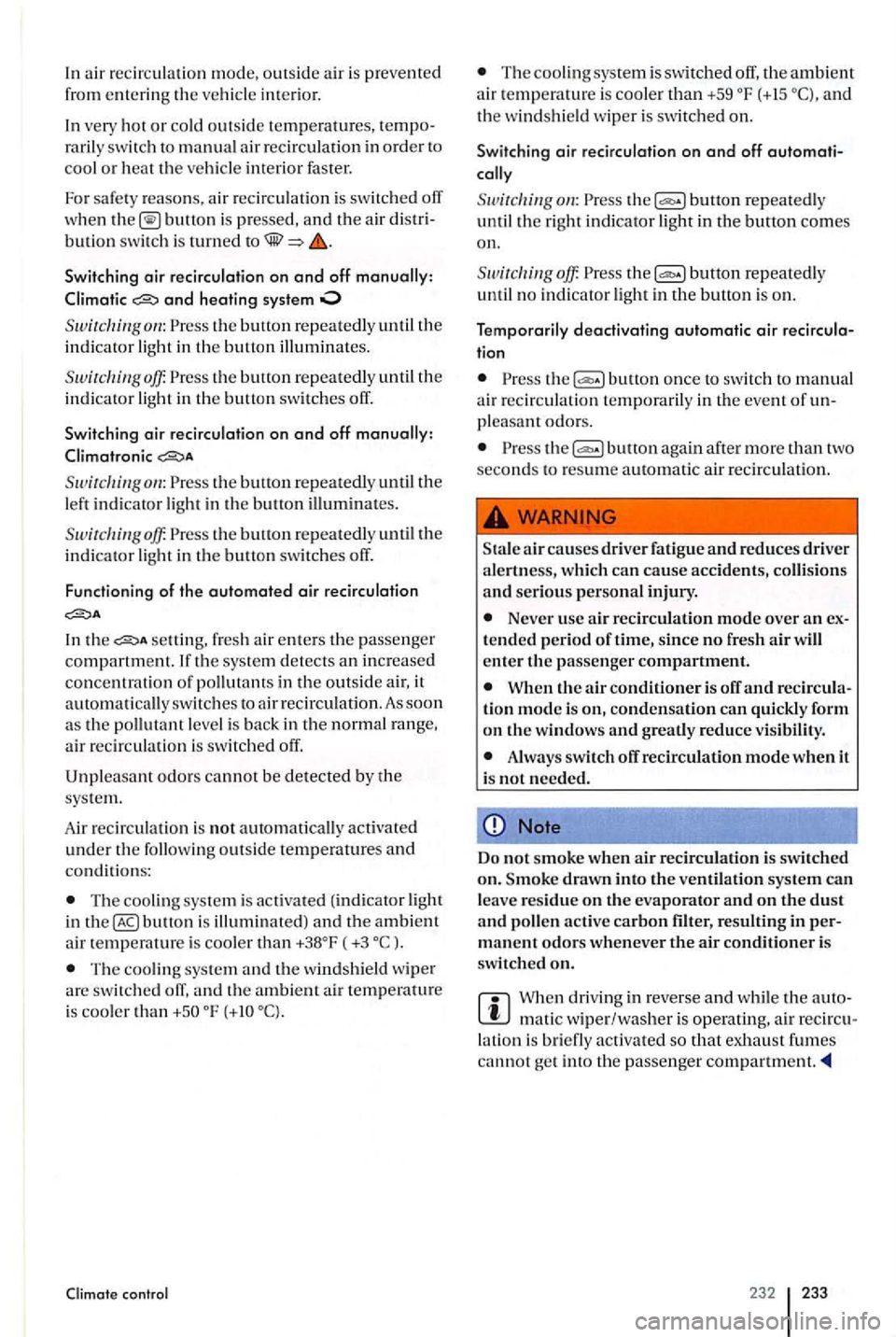
In air rec irculati on mod e, out sid e air is pre vente d
from ent
erin g the ve hicle inte rior.
In very hot or co ld out sid e t
emperature s, rarily sw itch to manual a ir recircula tion in orde r to cool o r heat th e ve hicle interior faster.
For safet y re aso ns, air recircu latio n is switch ed off when
and heating system
th e button repeated ly until the
indi cator ligh t in the button illumin ates.
the button re peatedly until the
indi cator light in the button switche s off.
Switching air recirculation on and off
the button re peatedly the left indi cato r light in the butto n iUuminates.
Swirclzin goff. the buHon repeatedly th e
i n d icato r ligh t in th e butto n swit ches off.
Functioning of the automated air recirculation
sett ing, fresh air ent ers the p assen ger compartment. If th e sys te m detects an in crease d
co ncentrat ion in the out side air, it automatically switches to air recirc ulation. As soon
a s th e po llut an t leve l is bac k in th e no rmal range,
air recirculati o n is switc h ed off .
Unpl
easa nt od ors can no t be detected by th e
sys tem.
A ir rec ir c ulati on i s n
ot automatically activated under th e followin g o utside tempe ratures and conditi ons:
The coo ling sys te m i s activa te d (indicato r light
in butt on is illum inated) an d th e ambient
air temperature is coo ler than ( +3 oc ).
The co oling sys te m and the w in dshie ld wipe r
are switc h ed off, and the ambien t a ir temperature
i s coo le r th an
Th e cooling sys te m i s switched th e am bient
a ir temperature is c oole r th a n +59 and
th e w indshi eld wip er is switched on.
Switching air recircu lation on and off
button repeatedly
until the rig ht ind icator light in th e button co mes on.
off. button re peate dl y
u ntil no indicat or light in the button is on.
Temporarily deactivating automatic air
butt on once to switch to m anual
a ir recirculatio n t emporarily in the event of
buH on aga in afte r more than two
seco nds to resume auto matic ai r recir cul atio n.
air ca uses driver fatigue and reduces dri ver
a lertness, which can cause accidents, collisions and serious personal injury.
Neve r use air recirculation mode over an tende d p eriod of lime, since no fre sh air will
e nt er the passen ge r compartment.
When the air conditioner is off and tion mode is condensat ion can quickly form on th e w indows and greatly reduce visibility.
Alwa ys sw itc h off recirculation mode when it
i s not needed.
Note
Do not smoke w hen air re circulation is switc hed draw n into the ventilation syste m can le ave residue on tl1e evaporator and on the dust and poll en acti ve carbon filter , resulting in mane nt odors wheneve r the air conditioner is switched
W hen driv in g in reverse and w hil e th e mati c wipe r/washer is op erating, air latio n is bri efly act ivate d so exh au st fumes canno t ge t into th e passenger
232 233